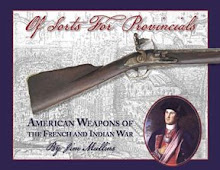
Portrait of James Lewis ca. 1772 by Charles Willson Peale at Colonial Williamsburg Foundation emuseum Note the blued barrel, keyed or wedge "sliding loop/sliding bolt" fastener, and brass mounts.
Undoubtedly the most common form of civilian firearm in Colonial Virginia; the fowling piece was a useful and versatile item capable of taking both large and small game depending on the size of the shot and charge that was used to load the piece. Advertisements and primary documents from the era point towards a predisposition in Virginia towards imported English fowling pieces, frequently with walnut stocks and around a four foot long barrel. Bores in the 1/2 inch, 5/8s inch and 3/4 inch range predominated. Some colonial era stores stocked fowling pieces (commonly referred to as "guns") at various price points. Customers could purchase ready made stock on hand, place orders with their custom specifications though their local stores, or, (in the case of the more prosperous gentry) order directly with English factors or Gunsmiths in England. Prices ranged due to the quality of locks, mountings and embellishment.
English Fowler by William Staples of Birmingham (d 1771). Private Collection
Alexander Henderson's Virginia Colchester Store Letterbook has the following order information from 1761:
1 doz. Guns at 10/per gun...1/2 doz. Guns at 15/per Gun + "PS at the Request of two of my very good Customers, I beg leave to add- 2 good & well fixed guns, the Barrell to be 4 feet 4 inches long and of good Substance, the Bore to be three quarter of an inch Diameter, with a very good Lock & Plain mounting- 1 ditto, the Barrell the same Length & substance with the above, the Bore to be half an Inch Diameter with good Lock & plain Mounting- These three Guns I would chuse to be very good but not too costly and I fancy London is the best place to order them from."
Brass trigger guard finial from a fowling piece excavated at Point of Fork Arsenal in Virginia. Giles Cromwell collection.
Invoice- London October, 1767, George Washington Papers June 6, 1765-March 9, 1775:
"1 Handsome fowling Piece 3 feet 2 inches in the Barl 3/4 inch bore, fine silver Mountg, with Water pan Lock, Walnut Stock, barrel blewed within a Silver Sight, a false britch and sliding bolts, worm to the Rammer & List Case [cost 8/8/0 ]" Gill Gunsmith in Colonial Virginia p13
David and William Geddy advertisement. Virginia Gazette, August 8, 1751
Although very affordable imports were widely available prior to the Revolution, it was sometimes advantageous to repair older fowling pieces. Williamsburg Gunsmith James Geddy advertised in 1739 that he had on hand "a long Gun, about 6 or 7 feet in the Barrell, was brought by a young Gentleman of Gloucester County, to me, the Subscriber, in Williamsburg, to be new Stock'd and Lock'd..." (Gill's Gunsmith of Colonial Virginia p28)
A composite long fowler from the Woodson family of Virginia survives in the collections of the Virginia Museum of History and Culture. The gun features an 0.80 caliber recycled 17th century barrel that is approximately 6 feet long, a round faced lock by Collicott of Bristol dating prior to 1773, and is brass mounted with reused Long land style British musket furniture. Overall length is 89 inches. A 1738 advertisement by James Geddy mentioned "large Guns fit for killing Wild-Fowl in Rivers." This very long barrel is indicative of such a use. Shorter, lighter guns were generally favored for upland hunting. Virginia Militiaman Thomas Kitchens mentioned "When I went out to Guilford I took my small shotgun..." in his pension application.
Jim Kibler recently uploaded a great video on the aesthetics of English fowlers from this period.





